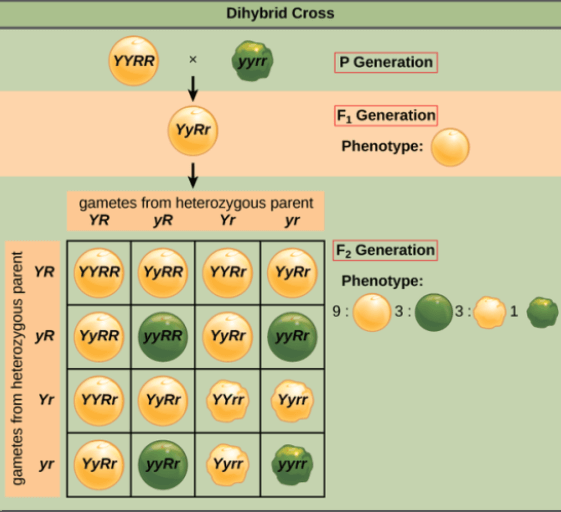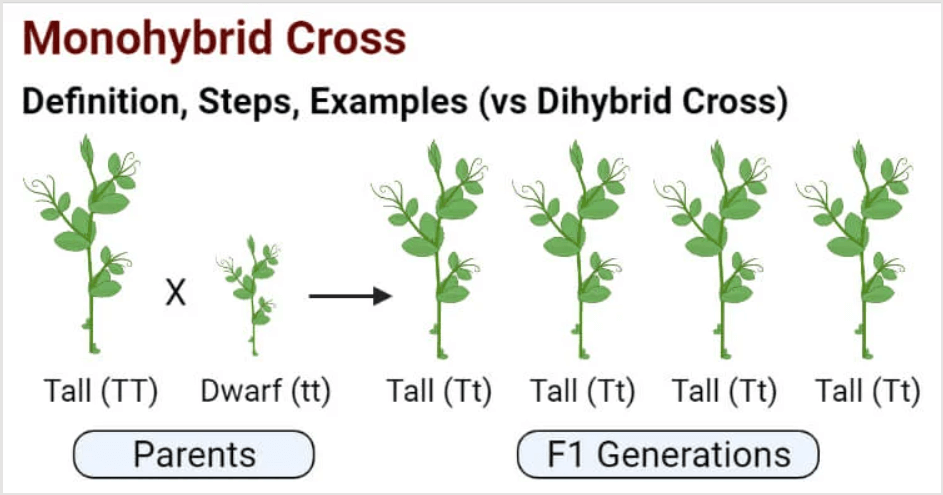Dihybrid and Monohybrid crosses are fundamental concepts in genetics, helping us understand how traits are inherited from one generation to the next. Both crosses are crucial in understanding Mendelian genetics, which forms the basis for more complex genetic studies in Biology. They help predict the outcomes of genetic crosses, allowing scientists and breeders to make informed decisions in fields like agriculture and medicine. Here we have briefly discussed the differences between the Dihybrid cross and the Monohybrid cross and their importance.
Dihybrid Cross and Monohybrid Cross
Monohybrid cross and Dihybrid cross are terms used in genetics to describe different types of breeding experiments involving specific traits. In summary, a monohybrid cross focuses on one trait, whereas a dihybrid cross-examines the inheritance patterns of two different traits. Both types of crosses are essential in understanding genetic inheritance and predicting the traits that offspring might inherit from their parents.
What is a Dihybrid Cross?
A dihybrid cross is a genetic cross between two individuals that differ in two traits, often represented as alleles of two different genes. In this type of cross, the inheritance patterns of body traits are studied simultaneously. This helps in understanding how different traits are inherited and how they segregate and assort independently during the formation of gametes. The results of dihybrid crosses can be explained using Mendel’s principles of Inheritance, such as the law of Segregation and the Law of Independent Assortment.

What is a Monohybrid Cross?
A monohybrid cross is a genetic experiment involving the mating of individuals differing in only one trait. This kind of cross focuses on a single characteristic, such as flower color or seed shape, and explores how that trait is inherited from one generation to the next. The results of monohybrid cross can be predicted using Punnett squares, a diagrammatic representation of possible combinations of alleles (different forms of a gene) from the parental organisms. This type of cross helps in understanding the basic principles of inheritance and the patterns of genetic traits in offspring.

Difference Between Dihybrid and Monohybrid Cross
Here we have discussed what are the differences between dihybrid and monohybrid crosses in a table form. These crosses are very important as both monohybrid and dihybrid crosses provide insights into how traits are inherited and how genes segregate and recombine during sexual reproduction.
| Difference Between Dihybrid and Monohybrid Cross | ||
| Aspects | Monohybrid Cross | Dihybrid Cross |
| Definition | A Monohybrid cross is a cross that involves one pair of traits. | A Dihybrid cross is a cross that involves two pairs of traits. |
| Number of traits | It involves only one trait. | Dihybrid cross involves two different traits. |
| Examples | Crossing two plants with different flower colors. | Crossing two plants with different flower colors and different seed shapes. |
| Punnette Square | 2×2 Punnett square used. | 4×4 Punnett square used. |
| Phenotypic Ratio | The phenotypic ratio is typically 3:1 in F2 generation. | The phenotypic ratio is typically 9:3:3:1 in F2 generation. |
| Genetic Segregation | Only one trait segregates in each generation. | Two different traits segregate independently in each generation. |
| Inheritance Pattern | Follows Mendelian inheritance for one trait. | Follows Mendelian inheritance for both traits independently. |
| Types of Alleles | Monohybrid cross involves two alleles, one from each parent, for a single gene. | A Dihybrid cross involves four alleles, two from each parent, for two different genes. |
| Offspring Variety | Produces offspring with two possible phenotypes (homozygous dominant and heterozygous). | Produces offspring with multiple phenotypic combinations (homozygous dominant, heterozygous for one trait, heterozygous for the other trait, homozygous recessive). |
| Independent Assortment | Monohybrid cross does not involve the principle of independent assortment. | Dihybrid cross involves the principle of independent assortment, where alleles for different traits segregate independently during gamete formation. |
| Genetic Variation | Generates less variation among offspring. | Generates more genetic variation among offspring due to the assortment of two different traits. |
| Parental Phenotypes | In monohybrid cross, both parents exhibit different phenotypes for the trait being studied. | In a dihybrid cross, both parents exhibit different phenotypes for two different traits being studied. |
Importance of Dihybrid and Monohybrid Crosses
Both monohybrid and dihybrid crosses are essential concepts in genetics that help scientists understand inheritance patterns. In summary, monohybrid crosses are crucial for understanding basic genetic principles, while dihybrid crosses extend this knowledge to study the inheritance patterns of multiple traits. Leading to diversity and inheritance. Both concepts are foundational in the field of genetics and have practical applications in various fields, including agriculture, medicine, and evolutionary Biology.
Importance of Dihybrid Cross
Here we have discussed a few points on the importance of the Dihybrid Cross below:
- Study of Two Traits: Dihybrid crosses involve the simultaneous study of two different traits. This helps in understanding the inheritance patterns of multiple genes and how they assort independently.
- Law of Independent Assortment: Dihybrid crosses led to the discovery of the law of independent assortment, which states that different genes segregate independently of each other during the formation of gametes. This principle is vital in understanding genetic diversity.
- Variability: Dihybrid crosses demonstrate the variety of traits that can be inherited. This diversity is important for the adaptation and evolution of species over generations.
- Genetic Mapping: Dihybrid crosses provide data that can be used for genetic mapping, allowing scientists to determine the relative locations of genes on chromosomes.
Importance of Monohybrid Cross
Here we have discussed a few points on the importance of the Monohybrid Cross below:
- Study of Single Traits: Monohybrid crosses involve the study of one trait at a time. This helps in understanding how a single gene is inherited from one generation to the next.
- Basic Understanding: Monohybrid crosses provide the fundamental principles of inheritance, like dominance, recessiveness, and segregation. They form the basis for more complex genetic studies.
- Predicting Phenotypes: By understanding monohybrid crosses, scientists and breeders can predict the phenotypic ratios of offspring, which is crucial in agriculture and selective breeding programs.



 50 Vegetables Name for Kids in English a...
50 Vegetables Name for Kids in English a...
 Food Chain: Definition, Types, Examples,...
Food Chain: Definition, Types, Examples,...
 Human Respiratory System: Definition, Di...
Human Respiratory System: Definition, Di...













